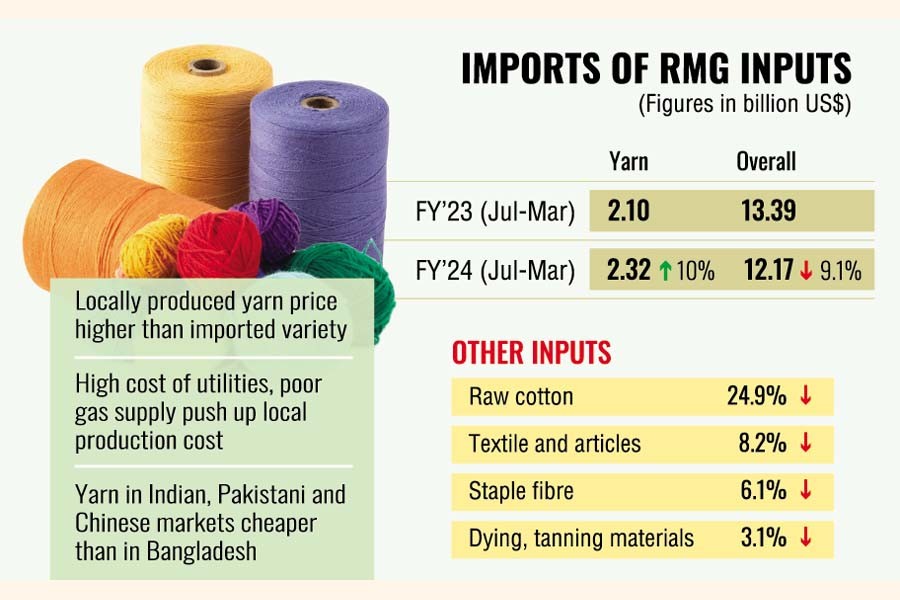
Local spinners losing yarn market to import surge
MONIRA MUNNI | Wednesday, 5 June 2024

Due to higher cost of production, domestic textile millers, especially spinners, are facing 'uneven' competition with their foreign competitors and losing orders for yarn even from the local readymade-garment exporters.
The RMG exporters now prefer sourcing the raw material from abroad, hindering further growth of the local spinning sector.
According to the central bank data, imports of yarn recorded a double digit growth during the first nine months of the current fiscal year (FY) while imports fell in cases of other raw materials like raw cotton, textile and articles, and staple fibre.
Yarn import recorded a growth of over 10 per cent during July-March period of FY 2023-24 compared to the corresponding period of the last FY, according to Bangladesh Bank data.
Bangladesh imported yarn worth US$2.32 billion during the period which was US$2.10 billion in July-March period of FY 2022-23.
Overall imports of RMG inputs recorded a 9.1 per cent decline during the first nine months - raw cotton 24.9 per cent, followed by textile and articles 8.2 per cent, staple fibre 6.1 per cent and dying and tanning materials 3.1 per cent.
During the period under review, the country spent US$12.17 billion in importing those goods which was US$13.39 billion in the corresponding period of last fiscal.
Exporters said the price of locally produced yarn is higher than the imported variety while textile millers argued that the high costs of utilities and poor gas supply pushed up their production cost and it resulted in higher prices of locally made yarn.
Syed Nurul Islam, chairman and chief executive officer of Well Group said that as import of raw materials like raw cotton and staple fibres declined, it is assumed that yarn import would see a rise. Yarn is required to manufacture fabrics and then readymade garments.
The group has six production units - one spinning, one fabric and four garment factories.
Garment exporters usually source raw materials like yarn and fabrics from the local market when they have pressure of work orders and have to shorten the lead times despite a price difference, he explained.
Moreover, prices of locally produced yarn have gone up due to high utility costs, shortage of gas supply, said Mr Islam, also a director of Bangladesh Textile Mills Association (BTMA).
On one hand, the cost increased and on the other they can't use full production capacity due to poor supply of gas, he added.
Local yarn is losing its competitiveness and garment exporters are sourcing yarn from outside the country under bonded warehouse facilities as Indian, Pakistani and Chinese yarn is cheaper than that of Bangladesh, he noted.
He, however, said that for survival and sustainability, the garment industry needs a strong backyard linkage supply and for that they need government's policy support.
Echoing this point, Faruque Hassan, former president of the Bangladesh Garment Manufacturers and Exporters Association (BGMEA), said it is not a good sign that despite a fall in imports of other raw materials, yarn import is increasing.
Local consumption has to be enhanced while there must be flexibility to bring more business in terms of garment work orders, he noted.
When asked, BGMEA President SM Mannan Kochi said local yarn prices are higher than imported ones.
Exporters are sourcing yarn from outside as they are not price competitive despite getting a cash incentive for sourcing from the local market, he explained.
BTMA President Mohammad Ali Khokon, however, alleged that importers are selling their yarn at a 'dumping price' as they get a number of policy support from their respective governments while they have their own cotton.
For example, he said, India has been providing different policy support to their local textile mills that included incentives on labour cost and electricity.
As a result, they can sell their product at the same rate of their production cost, he added.
"On the other hand, we don't have the main raw material-cotton while we are not getting required gas supply and that the bank interest rates have gone up to double digit," he said.
Explaining the impact, Mr Khokon said that if yarn is sourced from the local market, the US dollar would remain within the country. And if such a trend continues for a long time, many textile mills will face closure, failing to compete.
According to industry insiders, local textile mills meet about 80 per cent demand for the knitwear subsector and 35-40 per cent for woven.
Bangladesh fetched US$37.20 billion from RMG exports during July-March period of FY 2023-24 - knitwear earned US$21.01 billion and woven US$16.19 billion, according to the Export Promotion Bureau (EPB) data.
The country fetched US$47 billion in FY 2022-23.
Munni_fe@yahoo.com